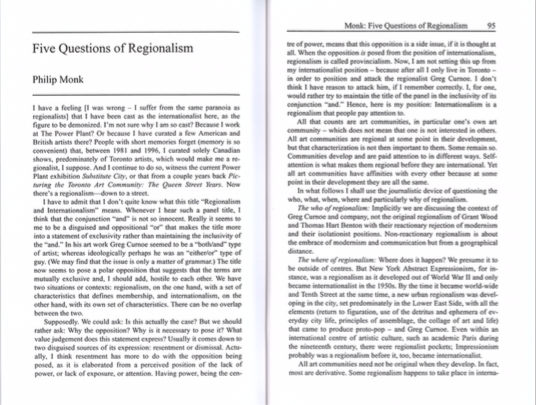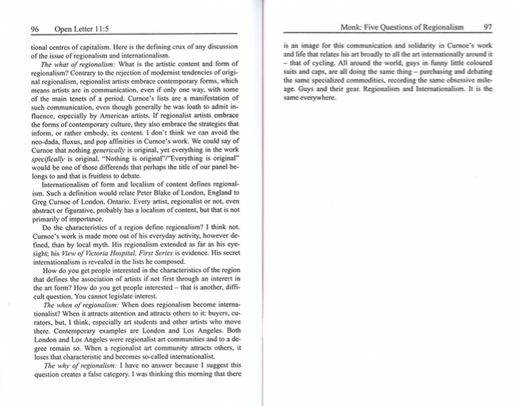Five Questions of Regionalism (2001)
[Presented at the May 2001 symposium "We Are Not Greg Curnoe," and published in Open Letter, Eleventh Series, No. 5 (Summer 2002).]
Five Questions of Regionalism
I have a feeling [I was wrong—I suffer from the same paranoia as regionalists] that I have been cast as the internationalist here, as the figure to be demonized. I’m not sure why I am so cast? Because I work at the Power Plant? Or because I have curated a few American and British artists there? People with short memories forget (memory is so convenient) that, between 1981 and 1996, I curated solely Canadian shows, predominately of Toronto artists, which would make me a regionalist, I suppose. And I continue to do so, witness the current Power Plant exhibition Substitute City, or that from a couple years back Picturing the Toronto Art Community: The Queen Street Years. Now there’s a regionalism—down to a street.
I have to admit that I don’t quite know what this title “Regionalism and Internationalism” means. Whenever I hear such a panel title, I think that the conjunction “and” is not so innocent. Really it seems to me to be a disguised and oppositional “or” that makes the title more into a statement of exclusivity rather than maintaining the inclusivity of the “and.” In his art work Greg Curnoe seemed to be a “both/and” type of artist; whereas art ideologically perhaps he was an “either/or” type of guy. (We may find that the issue is only a matter of grammar.) The title now seems to pose a polar opposition that suggests that the terms are mutually exclusive and, I should add, hostile to each other. We have two situations or contexts: regionalism, on the one hand, with a set of characteristics that defines membership, and internationalism, on the other hand, with its own set of characteristics. There can be no overlap between the two.
Supposedly. We could ask: Is this actually the case? But we should rather ask: Why the opposition? Why is it necessary to pose it? What value judgement does this statement express? Usually it comes down to two disguised sources of its expression: resentment or dismissal. Actually, I think resentment has more to do with the opposition being posed, as it is elaborated from a perceived position of the lack of power, or lack of exposure, or attention. Having power, being the centre of power, means that this opposition is a side issue, if it is thought at all. When the opposition is posed from the position of internationalism, regionalism is called provincialism. Now, I am not setting this up from my internationalist position—because after all I only live in Toronto—in order to position and attack the regionalist Greg Curnoe. I don’t think I have reason to attack him, if I remember correctly. I, for one, would rather try to maintain the title of the panel in the inclusivity of its conjunction “and.” Hence, here is my position: Internationalism is a regionalism that people pay attention to.
All that counts are art communities, in particular one’s own art community—which does not mean that one is not interested in others. All art communities are regional at some point in their development, but that characterization is not then important to them. Some remain so. Communities develop and are paid attention to in different ways. Self-attention is what makes them regional before they are international. Yet all art communities have affinities with every other because at same point in their development they are all the same.
In what follows I shall use the journalistic device of questioning the who, what, when, where and particularly the why of regionalism.
The who of regionalism: Implicitly we are discussing the context of Greg Curnoe and company, not the original regionalism of Grant Wood and Thomas Hart Benton with their reactionary rejection of modernism and their isolationist positions. Non-reactionary regionalism is about the embrace of modernism and communication but from a geographical distance.
The where of regionalism: Where does it happen? We presume it to be outside of centres. But New York Abstract Expressionism, for instance, was a regionalism as it developed out of World War II and only became internationalist in the 1950s. By the time it became world-wide and Tenth Street at the same time, a new urban regionalism was developing in the city, set predominately in the Lower East Side, with all the elements (return to figuration, use of the detritus and ephemera of everyday city life, principles of assemblage, the collage of art and life) that came to produce proto-pop—and Greg Curnoe. Even within an international centre of artistic culture, such as academic Paris during the nineteenth century, there were regionalist pockets; Impressionism probably was a regionalism before it, too, became internationalist.
All art communities need not be original when they develop. In fact, most are derivative. Some regionalism happens to take place in international centres of capitalism. Here is the defining crux of any discussion of the issue of regionalism and internationalism.
The what of regionalism: What is the artistic content and form of regionalism? Contrary to the rejection of modernist tendencies of original regionalism, regionalist artists embrace contemporary forms, which means artists are in communication, even if only one way, with some of the main tenets of a period. Curnoe’s lists are a manifestation of such communication, even though they do not, disingenuously, mention artists—or maybe only not acknowledge American artists. If regionalist artists embrace the forms of contemporary culture, they also embrace the strategies that inform, or rather embody, its content. I don’t think we can avoid the neo-dada, fluxus, and pop affinities in Curnoe’s work. We could say of Curnoe that nothing generically is original, yet everything in the work specifically is original. “Nothing is original”/”Everything is original” would be one of those differends that perhaps the title of our panel belongs to and that is fruitless to debate.
Internationalism of form and localism of content defines regionalism. Such a definition would relate Peter Blake of London, England to Greg Curnoe of London, Ontario. Every artist, regionalist or not, even abstract or figurative, probably has a localism of content, but that is not primarily of importance.
Do the characteristics of a region define regionalism? I think not. Curnoe’s work is made more out of his everyday activity, however defined, than by local myth. His regionalism extended as far as his eyesight; his View of Victoria Hospital, First Series is evidence. His secret internationalism is revealed in the lists he composed.
How do you get people interested in the characteristics of the region that defines the association of artists if not first through an interest in the art form? How do you get people interested—that is another, difficult question. You cannot legislate interest.
The when of regionalism: When does regionalism become internationalist? When it attracts attention and attracts others to it: buyers, curators, but, I think, especially art students and other artists who move there. Contemporary examples are London and Los Angeles. Both London and Los Angeles were regionalist art communities and to a degree remain so. When a regionalist art community attracts others, it loses that characteristic and becomes so-called internationalist.
The why of regionalism: I have no answer because I suggest this question creates a false category. I was thinking this morning that there is an image for this communication and solidarity in Curnoe’s work and life that relates his art broadly to all the art internationally around it—that of cycling. All around the world, guys in funny little coloured suits and caps, are all doing the same thing—purchasing and debating the same specialized commodities, recording the same obsessive mileage. Guys and their gear. Regionalism and Internationalism. It is the same everywhere.


